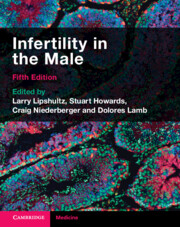Book contents
- Infertility in the Male
- Infertility in the Male
- Copyright page
- Contents
- Contributors
- Foreword
- Abbreviations
- Introduction
- Section 1 Scientific Foundations of Male Infertility
- Chapter 1 Anatomy and Embryology of the Male Reproductive Tract and Gonadal Development, the Epididymis, and Accessory Sex Organs
- Chapter 2 Cellular Architecture and Function of the Testis
- Chapter 3 Maturation and Function of Sperm
- Chapter 4 The Male Reproductive Endocrine System
- Chapter 5 Erection, Emission, and Ejaculation
- Chapter 6 Genomics, Epigenetics, and Male Reproduction
- Section 2 Clinical Evaluation of the Infertile Male
- Section 3 Laboratory Diagnosis of Male Infertility
- Section 4 Treatment of Male Infertility
- Section 5 Health Care Systems and Culture
- Index
- References
Chapter 5 - Erection, Emission, and Ejaculation
from Section 1 - Scientific Foundations of Male Infertility
Published online by Cambridge University Press: 08 July 2023
- Infertility in the Male
- Infertility in the Male
- Copyright page
- Contents
- Contributors
- Foreword
- Abbreviations
- Introduction
- Section 1 Scientific Foundations of Male Infertility
- Chapter 1 Anatomy and Embryology of the Male Reproductive Tract and Gonadal Development, the Epididymis, and Accessory Sex Organs
- Chapter 2 Cellular Architecture and Function of the Testis
- Chapter 3 Maturation and Function of Sperm
- Chapter 4 The Male Reproductive Endocrine System
- Chapter 5 Erection, Emission, and Ejaculation
- Chapter 6 Genomics, Epigenetics, and Male Reproduction
- Section 2 Clinical Evaluation of the Infertile Male
- Section 3 Laboratory Diagnosis of Male Infertility
- Section 4 Treatment of Male Infertility
- Section 5 Health Care Systems and Culture
- Index
- References
Summary
This chapter deals with clinically relevant aspects of sexual function relating to erection and ejaculation. Such a discussion naturally begins with an exploration of the penile anatomy.
- Type
- Chapter
- Information
- Infertility in the Male , pp. 77 - 93Publisher: Cambridge University PressPrint publication year: 2023



